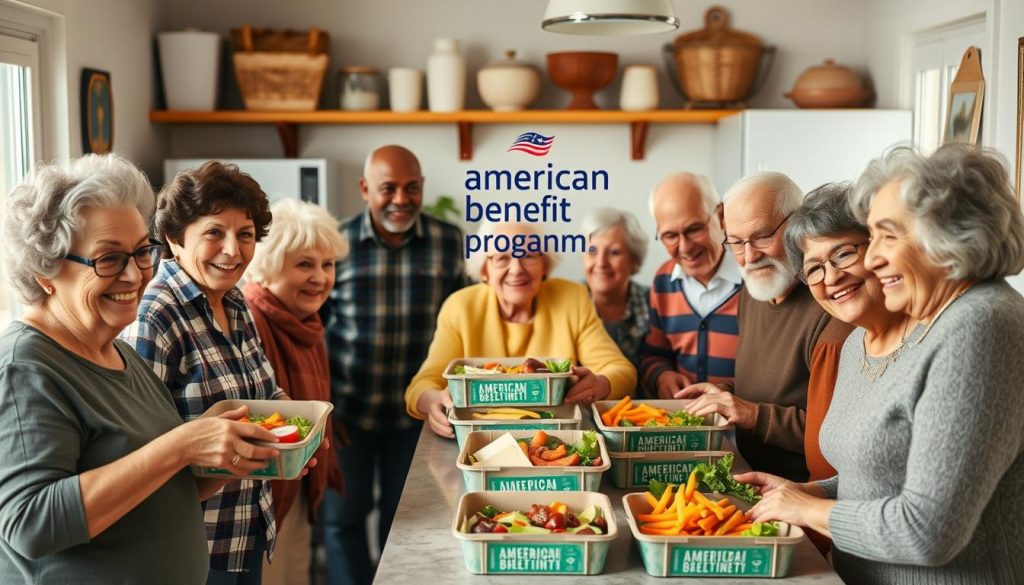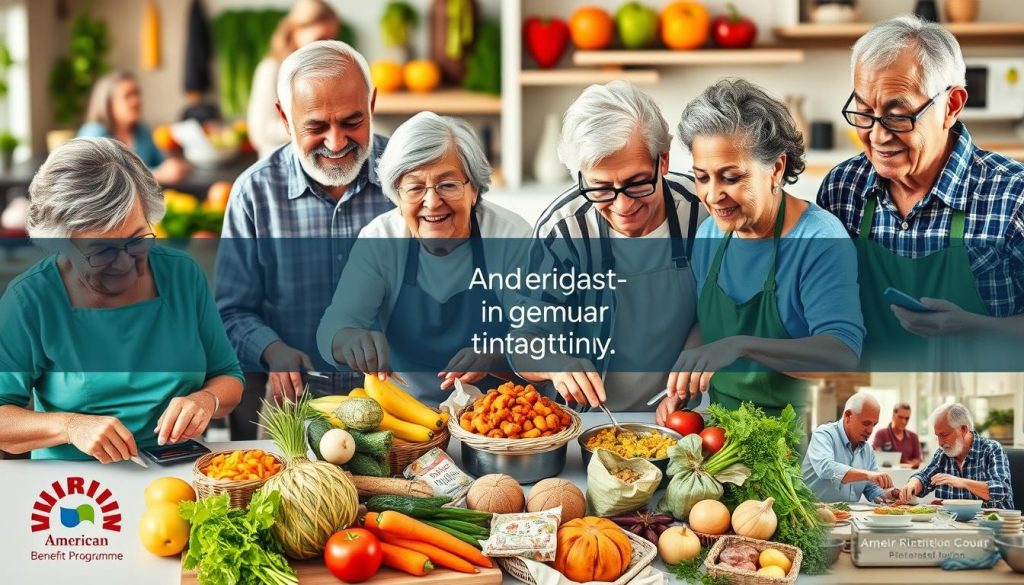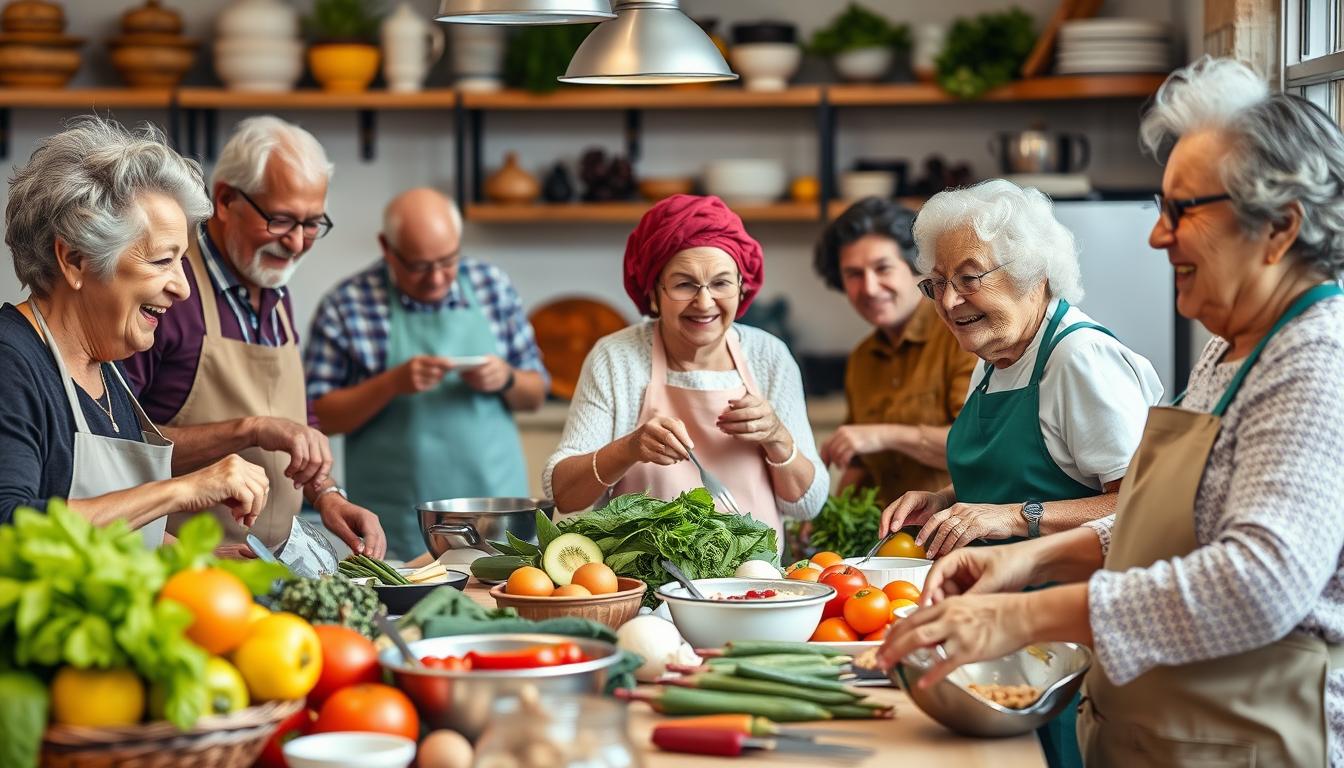Do you know many older adults might not get the vital nutrition they need? It’s very important to know about senior nutrition programs as the number of people 65 and older will increase by 20301. These programs help a lot by delivering meals to seniors and making sure they get the right foods. This guide will help you learn how to get these important food services for the elderly.
Key Takeaways
- Senior nutrition programs are crucial to supporting the health of individuals aged 60 and above.
- Programs like Meals on Wheels offer essential meal delivery for seniors facing food insecurity.
- The eligibility criteria often focus on age, income, and social needs of older adults.
- Community collaboration fosters innovative solutions in access to elderly nutrition support.
- Understanding the diverse types of senior meal programs can help seniors take full advantage of available resources.
Understanding Senior Nutrition Programs
Senior nutrition programs help those 60 and older. They fight hunger and lack of food2. These programs offer meals that meet seniors’ special dietary needs. This helps seniors stay healthy and active2. In the U.S., about 1 in 6 seniors struggle with not having enough food3.
Groups like Meals on Wheels deliver over 1 million meals daily. This helps seniors get the nutrition they need3. These programs also bring seniors together to eat. This is good for their mental and emotional health2. About 4.8 million adults over 60 use SNAP. They get around $104 a month, which helps a lot with buying food3.
Programs like the Senior Farmers’ Market Nutrition Program help too. They give low-income seniors access to fresh produce4. The federal government funds these programs through the Older Americans Act. This improves seniors’ lives by making sure they have good nutrition2.
The Purpose of Senior Nutrition Programs
Senior nutrition programs are crucial for improving older adults’ lives. They aim to lessen hunger and poor nutrition. This helps to keep them healthy and full of life. By offering the right help, these initiatives deal with the food issues many seniors face. They make sure older people have what they need to eat well.
Key Goals of the Programs
Key goals include:
- Lowering the chance of food shortages. About 1 in 6 elderly Americans face this issue every day3.
- Bringing people together for meals to help make friends. This helps fight loneliness for many3.
- Offering meals that are good for the brain, bones, and heart. This boosts seniors’ health5.
Targeted Populations
Programs primarily target:
- Seniors with low incomes. Over 7 million older people are living with not enough money3.
- People from minority groups. This helps those who face extra hurdles to get the nutrition help they need.
- Those living in rural areas or with physical disabilities. This makes getting fresh, healthy food hard.
- Older adults using SNAP benefits. They get about $104 a month, which barely covers food needs3.
Eligibility Criteria for Senior Nutrition Programs
People 60 years or older may qualify for senior food help. They look at your income to see if you really need it. This is to make sure help goes to those who need it most, like low-income seniors.
Aging and Economic Need
Being 60 or older is the main thing needed to get this food help6. They also give extra help to sick or disabled seniors with money troubles7. They check things like how much money you make. If you are married, your spouse can get meals too, no matter how old they are. This helps even more people6.
Additional Eligibility Factors
Other things can affect if you can join in these food programs. Local places check if you can join by looking at many things. They like when people help out at meal times6. Sometimes, they change the rules so more people can get help, especially those who need it most8.
Types of Senior Nutrition Services Available
There are vital programs for older people to help with their eating needs. These services are made to give them good, healthy meals. We will talk about three kinds of services: Home-Delivered Meal Services, Congregate Meal Programs, and Food Assistance Initiatives.
Home-Delivered Meal Services
Home-Delivered Meal Services help seniors who can’t move around much. They bring meal delivery for seniors right to their door, up to five days a week. These meals are hot and cover one-third of what seniors need to eat every day as diet experts say9. Anyone who is old enough can get this help, money doesn’t matter9. They even have special meals if you need them, like vegetarian or pureed food9.
Congregate Meal Programs
Congregate Meal Programs are for enjoying meals with others. Anyone 60 or older can join in9. These meals are a chance to meet and talk with others. You might have to tell them you’re coming before you show up9. The meals are at places like senior centers or schools, making everyone feel welcome10.
Food Assistance Initiatives
Food Assistance Initiatives help seniors who don’t have much money. Programs like CSFP give extra food every month10. You need to be over 60 and make less money than a set amount10. Meals on Wheels and others reach out across the country. They do more than give out food, helping with things like fixing homes too11.

How to Access Nutrition Assistance for Older Adults
Getting help with nutrition is key for older adults to stay healthy. They can contact their local Area Agencies on Aging (AAA) to find out about senior meal programs. Many might get help through the Supplemental Nutrition Assistance Program (SNAP). In 2022, almost 7 million older Americans didn’t have enough food. This could go up to 9 million by 205012.
To sign up for SNAP, seniors need to meet certain rules like income and where they live13. About 9 million could get SNAP, but only 30% have signed up12. We need to tell more people about this help so they don’t miss out12.
Other programs like the Senior Food Box Program give seniors food worth about $50 each month. Meals on Wheels and food banks are also there to help, with around 60,000 meal programs across the country12. Seniors can check online tools like BenefitsCheckup from the National Council on Aging (NCOA) for more help. Plus, state programs like the Senior Farmers’ Market Nutrition Program let them buy fresh produce13.
Collaboration with Local Food Retailers
Working with local food stores and restaurants boosts senior nutrition programs. These partnerships offer many meal choices and help in hard times, like during COVID-19. They improve food availability and build strong ties between service providers and local shops. This all helps to meet the changing food needs of older folks.
Building Partnerships
Food stores play a big part in helping feed elderly people. They can cater to nutrition programs or help deliver meals. In one year, a program gave out $20.4 million in coupons to 811,000 seniors, showing how local efforts help14. By working together, food retailers promote healthy eating, support local farms, and cut down on food waste.
Innovative Delivery Models
Food stores can offer more choices with creative delivery, like mobile services or teaming up with senior centers. A program called Nourish New York gave out over 100 million meals, showing how teamwork between food banks and local farms helps15. This helps get more food options to seniors and supports local farmers, which is good for everyone.
| Partnership Type | Description | Expected Benefits |
|---|---|---|
| Meal Delivery Collaboration | Grocery stores provide meal delivery services to seniors’ homes. | Increased access to nutritious meals, improved convenience, and reduced isolation. |
| Catering Services | Local restaurants partner to offer healthy meal options for program events. | Variety of meals, engagement with local businesses, and community support. |
| Food Drives | Grocery stores host food drives to collect healthy food items for seniors. | Boosted food access, decreased waste, and community involvement. |
For info on partnering with senior nutrition programs, resources are available here. For tips on creating partnerships, visit this resource.
RiseBoro’s programs show success in linking with local farms to provide meals. They also empower communities by making food support connections16.
Meal Planning and Nutritional Guidelines
Meal planning helps seniors get the nutrients they need for a healthy life. It is key to know what nutrients they need most. This knowledge helps make meals that are good for their health.
Understanding Nutritional Needs of Seniors
Seniors need a mix of foods from all groups to avoid diseases like high blood pressure. It’s important to pick foods low in sugar, fat, and salt. Getting enough protein is essential for keeping muscles strong.
They also need potassium, calcium, vitamin D, fiber, and vitamin B12 for good health. Drinking more water is also a must for staying hydrated, especially as seniors may not feel thirsty often.
Creating Balanced Meal Options
Nutritionists suggest using guides like the USDA’s Healthy U.S.-Style or Mediterranean-Style Eating Patterns. These focus on whole foods like fruits, veggies, and grains. They also provide shopping lists to help find the right foods for seniors.
Adding easy, tasty recipes such as 20-Minute Chicken Creole and Apple Carrot Soup makes eating well more enjoyable. These meals bring joy and health together.
Nutrition Services for Elderly in Communities
Community nutrition programs are key for elderly well-being. They offer nutritious meals and help seniors make friends. This helps fight loneliness. Every day, over 900,000 meals reach people aged 60+ through Older Americans Act nutrition services. This shows the big role these efforts play in supporting senior food programs17.
Importance of Community Programs
Community nutrition services help older adults eat well. The Senior Nutrition Program gives meals in groups or home delivery. This helps those who can’t leave their homes or move easily. These services ensure seniors eat right and stay independent. They also improve health. About 72% say they feel healthier thanks to these meals. This links good food with better wellness18.
Local Resources and Organizations
Local groups and Area Agencies on Aging understand what seniors need to eat well. They work with meal services to reach all kinds of seniors. This includes those who don’t speak English well or have little money. For more on these services, elderlies can check the Elderly Nutrition Program in San Bernardino County. It has group and home delivery meals for those who qualify
Challenges Facing Senior Nutrition Programs
Senior nutrition programs face big challenges. They struggle with not having enough money or resources. This makes it hard for them to help as many older people as they need to.
Funding and Resource Allocation
Last year, helping older adults eat healthy got more expensive. Food prices went up a lot, by 9.9%. This made it the biggest jump in over 40 years. Because of this, healthcare costs linked to not eating well reached $147 billion. Out of this, $15.5 billion was just for treating these issues19.
Also, the federal poverty line in 2021 was low. It was $12,880 for one person and $17,420 for two. Yet, half of the older adults in the US made less than $27,38219. This shows that many seniors might find it hard to get the right food they need through meal programs.
Adapting to Increased Demand
More older adults want meals and nutrition help nowadays. Many of them can’t taste food well, actually 60% of those over 6519. To help, programs offer meals to grab and take home. They also deliver meals to those who can’t go out. Changing how they work helps them reach more people.
In September 2022, there was an important meeting. It was the White House Conference on Hunger, Nutrition, and Health20. They talked about how to fight illnesses that happen because of bad eating habits. They also discussed how to teach older adults about eating better. Finding new ways to do things and creating good policies are key. They help make sure older adults get steady support from nutrition programs.
Future Trends in Senior Nutrition Programs
Adding tech to senior nutrition help is a big change. It makes getting food help easier for the elderly. They use the internet to ask for meals and talk to diet experts from home.
Technology Integration
Soon, easy tech will help deliver services better. Systems will track meals to help those who need it most. This helps older people, especially in far places, get the food help they need.
Less than one in four old people use the OAANP21. Plus, more seniors faced hunger between 2001 and 2012—a jump of 66%21.
Improving access is key, as 63% of U.S. areas, with high hunger, are rural21. Also, 1 in 2 elders could be malnourished22. Tech helps them manage their food needs better, improving health and happiness.

| Aspect | Current State | Future Direction |
|---|---|---|
| Access to Nutrition Services | Limited access for many seniors | Increased use of technology for easy access |
| Food Insecurity Rates | 66% increase in older adults experiencing food insecurity | Programs aimed at decreasing food insecurity |
| Malnutrition Risk | 1 in 2 older adults at risk of malnutrition | Innovative solutions to reduce malnutrition risks |
Conclusion
Senior nutrition programs help older adults stay healthy by providing important food services. They tackle food insecurity and support elderly nutrition, especially in diverse groups. Meals for seniors bring food and help them connect with others, boosting their mental health and how well they fit into the community.
Knowing about the different services, who can get them, and how to sign up helps seniors and their families choose wisely232425. As more people need these services, it’s important to support and fund them. This ensures all seniors get the nutritious meals they need for a healthy life.
Looking ahead, focusing on nutrition plans made just for older adults is crucial. By making these vital programs a priority, we aim for a healthier future for our aging population. This means giving them access to a variety of good, nutritious food options.
Source Links
- Senior Nutrition Program Guide to Prioritizing Clients
- The Power of Elderly Nutrition Programs
- What to Know About Senior Nutrition Programs
- Nutrition Programs for Seniors | Nutrition.gov
- Top 3 Benefits Of Senior Nutrition Programs
- Program Narrative & Fact Sheets – Home-Delivered Nutrition | California Department of Aging
- Nutrition Program | South El Monte, CA
- Senior Nutrition – Seniors First
- Senior Nutrition Programs – AgeGuide
- Senior Nutrition | OlyCAP
- Find Meals | Meals on Wheels America
- Where Can I Find Food Help Near Me?
- Nutrition Assistance Programs
- Senior Farmers Market Nutrition Program – National Sustainable Agriculture Coalition
- Feeding New York Families: Governor Hochul Announces More Than 100 Million Meals Distributed Through Nourish New York Program
- RiseBoro | Food and Nutrition
- Nutrition Services | ACL Administration for Community Living
- Elderly Nutrition Program
- Common Challenges To Senior Nutrition – MeetCaregivers
- Nutritional Policies, Practices, and Challenges That Affect Older Adults – Assessing Intake of Food and Dietary Supplements in Older Adults
- No Reservations Required: Establishing Senior Nutrition Program & Restaurant Partnerships in the Age of COVID-19
- Silverleaf Eldercare
- Enriching nutrition programs to better serve the needs of a diversifying aging population
- How Does the Senior Nutrition Program Benefit Seniors? – Westmont Living
- Report on Service Equity in Older Americans Act Nutrition Program

Leave a Reply